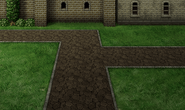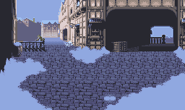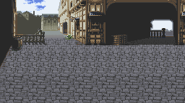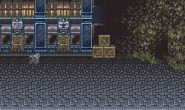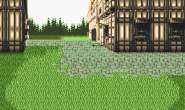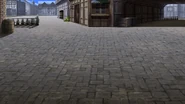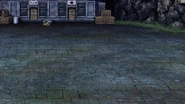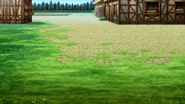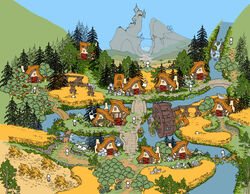

A town (町, Machi?) is a game element in the Final Fantasy series, where the player can rest, revive party members, buy armor, items, weapons or magic spells, hear rumors and various information given by NPCs or even catch ferries to other areas. Towns are often in the heroes' way to their goal, and are crucial on quests, since various events necessary for the story to progress may take place in these areas.
They are usually accessed via world map especially in the older series's games and are typically void of random encounters, although boss battles may occur in towns. Most notable exceptions are where town areas may also serve as playable areas with monster encounters as in Final Fantasy VIII depending on when the town is visited in the game, and Final Fantasy XIII where every town is treated nearly equal as dungeons. Some towns may be located near castles, or castles may even be towns themselves. In few cases, access into towns is restricted until a certain point in the game. Also certain visitable "towns" only serve as ruins, now devoid of their once ancient civilization.
The usual background music for towns in early installments of the series had each game's own staple town theme, which is usually a calm and peaceful melody. Beginning with Final Fantasy VII each town began to have more various musical variations, with many having their own themes that play only when that certain town is visited, giving it more of a unique motif that separates it from other towns.
Appearances
Final Fantasy

Towns are home to inns, weapon, magic, armor and item shops and churches. Saving was only possible by sleeping at an inn, or using a Tent or similar item, until the Dawn of Souls version.
Final Fantasy II

Saving is no longer available by sleeping at an inn, since the player can now save anywhere on the world map. Shops can be found inside dungeons (Tropical Island has an indigenous village, while Jade Passage has a hidden shop in the waterfall room).
Final Fantasy III
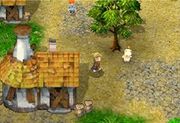
Towns now have different background themes and a complete town can be found inside a dungeon. Properties of towns can also be found inside airships.
- Ur
- Kazus
- Canaan
- Tozus
- Vikings' Cove
- Tokkul
- Village of the Ancients
- Gysahl
- Dwarven Hollows
- Amur
- Replito
- Duster
- Saronia
- Doga's Manor
- Doga's Village
- Ancient Ruins' (Encampment)
- Falgabard
Final Fantasy IV and Final Fantasy IV: The After Years
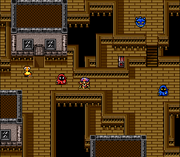
Towns without an inn exist and castle-towns also appear.
- Baron
- Kaipo
- Fabul
- Mysidia
- Troia
- Mist
- Mythril
- Agart
- Dwarven Castle
- Cave of Eblan
- Tomra
- Feymarch
- Hummingway Home
Final Fantasy V
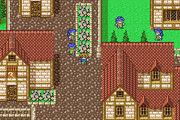
Towns no longer have one building/room per merchant. The world is divided in three world maps, and not all towns are available in each world.
- Tule
- Carwen
- Walse
- Karnak
- Crescent
- Jachol
- Istory
- Lix
- Regole
- Castle of Bal
- Quelb
- Surgate Castle
- Moogle Village
- Moore
- Phantom Village
Final Fantasy VI
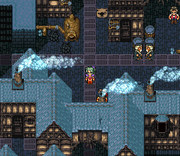
Many towns are featured, some of which approach city size. Zozo is a town that is actually more of a dungeon, as it has puzzles and random encounters and no shops. Narshe becomes a dungeon in the World of Ruin, having random encounters and the shops are no longer available.
- Narshe
- Figaro Castle
- South Figaro
- Returner Hideout
- Mobliz
- Nikeah
- Kohlingen
- Jidoor
- Zozo
- Maranda
- Tzen
- Albrook
- Vector
- Thamasa
Final Fantasy VII

Numerous larger towns and cities are featured. Midgar and Junon are so large sections of them could be considered towns on their own.
- Midgar (Slums, Wall Market, and Sectors)
- Kalm
- Fort Condor
- Junon
- Costa del Sol
- North Corel
- Gold Saucer
- Gongaga Village
- Cosmo Canyon
- Nibelheim
- Rocket Town
- Wutai
- Bone Village
- Icicle Inn
- Mideel
Final Fantasy VIII
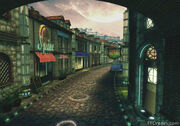
In addition to the usual facilities, one can also rent cars in most towns.
Final Fantasy IX
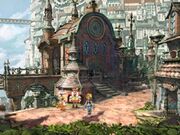
There are many towns in which technological advances vary and house different races of people. Burmecia is a perpetually rain-drenched town that plays like a dungeon as it is full of random encounters.
- Alexandria
- Dali
- Lindblum
- Summit Station
- Cleyra
- Treno
- Conde Petie
- Black Mage Village
- Madain Sari
- Esto Gaza
- Daguerreo
- Bran Bal
- Burmecia
Final Fantasy X and Final Fantasy X-2
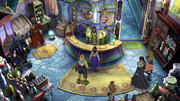
Few towns are featured, due to Spira being under constant threat of Sin. In place of more traditional towns it has numerous outposts referred to as Rin's travel agencies, which contained inns, shops, and save spheres.
Towns
Travel Agency Locations
Final Fantasy XI
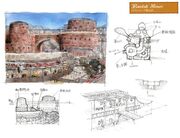
Cities are very large and feature auction houses, specialized vendors for all the player's needs, guards which start the player on missions, craftsmen who can teach the player various professions, as well as the player's Mog House, where they can change their jobs and which they can decorate to their liking. There are also smaller towns which lack the Auction Houses and Mog House, and have a smaller selection of vendors and craftsmen, but are still valuable as sanctuaries in the field.
Cities
Towns
Final Fantasy XII
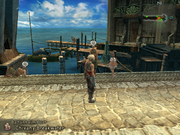
The towns are large, with several areas for the player to explore, and are mostly densely populated. While residences are not available for the player to access, shops are generally dotted around the location, and several contain bars or taverns in which the player can observe the Hunt board.
Final Fantasy XIII

There are no traditional towns featured, as such each are equivalent of dungeons with enemy encounters, and Gran Pulse lacks modern human civilization leaving towns dead. Shops have been replaced by the online market, and the party is fully healed after each battle, doing away with the need for inns. There are few instances of explorable areas that lack enemy encounters such as the Lindblum airship, Bartholomew Estheim's residence, and so on. However at most towns are treated nearly the same as dungeons with their only difference being that on Cocoon towns contain Human NPC's that offer dialogue when approached.
Cocoon
Gran Pulse
Final Fantasy XIII-2

Several town areas are now distinguishable by the absence of random encounters and a relatively greater presence of NPCs. As locations show different landscapes and accessible areas between different ages, town areas are not persistent in every instance of a location.
- New Bodhum -003 AF-
- Bresha Ruins -005 AF- (Excavation Site)
- Paddraean Archaeopolis (Excavation Site)
- Archylte Steppe -??? AF- (Hunters Settlement)
- Academia -4XX AF-
- Serendipity
Lightning Returns: Final Fantasy XIII
The world Nova Chrysalia has two city continents and two natural continents. There are several towns on two natural continents. Depending on the time of day different areas are available.

- Luxerion
- Yusnaan
- Ruffian
- Canopus Farms
- Research Camp
- Aryas Village
- Jagd Village
- Poltae
- Moogle Village
Final Fantasy XIV
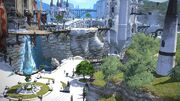
Nearly every region features at least one small settlement that contain varying amounts of amenities, such as Aetherytes, porters, levemetes, mail, merchants, and menders. There are also the larger cities, housing districts and endgame hubs that mostly exist in their own separate instance. These feature most or all the prior amenities as well as services that can only be found within their bounds.
Cities provide access to Market Boards, hunt boards, Grand Companies, Guilds, retainers, inns, and airship or naval travel between them, and are the most frequently visited locations in the story. New players will start in the cities of Limsa Lominsa, Ul'dah, or Gridania depending on their initial discipline. Housing districts play host to several plots on which both individual players and Free Companies can build customizable houses or purchase an apartment, and also have market board and retainer access. Endgame hubs are smaller cities or towns that provide access to specialized vendors that trade in Allagan tomestones and other tokens, in exchange for the majority of each expansion cycle's endgame equipment, in addition to boasting retainer access. These hubs can typically only be accessed near the end of that expansion's main storyline.
Cities
Housing districts
Endgame hubs
Final Fantasy XV
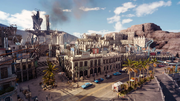
Few large towns exists in Eos. Despite this Lucis mainland does harbor many outposts, which function similar to towns. The low number of separate large settlements is likely influenced by the Starscourge and daemons it brings, making it dangerous to travel at night and not worthwhile to expand living areas to remote places.
Towns
Outposts
- Hammerhead
- Longwythe Rest Area
- Prairie Outpost
- Galdin Quay
- Coernix Station - Alstor
- Wiz Chocobo Post
- Coernix Station - Cauthess
- Taelpar Rest Area
- Cauthess Rest Area
- Burbost Souvenir Emporium
- Cape Caem
- Meldacio Hunter HQ
- Cartanica
Final Fantasy XVI
The settlements of Valisthea in Final Fantasy XVI offer a more subdued approach to urban environments compared to previous entries in the series, favoring smaller towns integrated into vast field areas over sprawling metropolises. The landmass of Valisthea, divided between the regions of Storm and Ash, features notable locations like Rosalith, the capital of Rosaria with its imposing Phoenix Gate, and Lostwing, a humble village that becomes populated with NPCs after players complete certain objectives. Other explorable settlements include the Free Cities of Kanver, a bustling mercantile hub, and key waypoints like Martha’s Rest or Oriflamme, while areas like Reverie and Drake’s Spine serve as striking, story-driven landmarks rather than traditional towns. Unlike earlier Final Fantasy titles known for their memorable, freely navigable cities—such as Rabanastre in XII or Lindblum in IX—XVI takes a narrative-focused approach, limiting access to certain areas based on story progression. These settlements act as atmospheric waypoints, enhancing the broader journey across the war-torn realm. Below are a sample of cities and smaller locations.
Cities
Settlements
- Martha’s Rest
- Eastpool
- Lostwing
- Northreach
- Port Isolde
- Dalimil
- Boklad
- Tabor
- The Hideaway
Final Fantasy Tactics
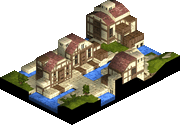
Towns are not explorable, but have shops, recruitment offices and pubs where the player can listen to rumors and undertake errands. Battles can initiate in towns during story segments.
- Eagrose Castle
- Magick City of Gariland
- Merchant City of Dorter
- Lionel Castle
- Castled City of Zaland
- Port City of Warjilis
- Clockwork City of Goug
- Limberry Castle
- Zeltennia Castle
- Trade City of Sal Ghidos
- Riovanes Castle
- Walled City of Yardrow
- Royal City of Lesalia
- Mining Town of Gollund
- Free City of Bervenia
Final Fantasy Crystal Chronicles
A few number of settlements are featured, most having a respective Crystal Caravan:
Final Fantasy Crystal Chronicles: Ring of Fates
Final Fantasy Crystal Chronicles: Echoes of Time
Final Fantasy Mystic Quest

A single town for each of the four regions is featured.
Final Fantasy Adventure
Towns are located throughout the world.
Final Fantasy Legend II
Towns are located throughout the various worlds.
- Home Town
- First Town
- Second Town
- Desert Town
- Ashura's Town
- Giant's Town
- Abandoned Giant's Town
- Lynn's Village
- Port Town
- Guardian's Town
- Venus' City
- Dirty Village
- Race Circuit
- Edo
- Hana's Town
- Final Town
Final Fantasy Legend III
Towns are located throughout the world.
- Dharm
- Elan
- Lae
- Muu
- New Dharm
- Viper City
- Eitar's Village
- Darius
- Knaya
- Talonsburg
- Zhakal
- Porle
- Cirrus
- Dwelg Town
- Donmac
Final Fantasy Dimensions
There are many towns located throughout the world.
- Lux
- Harmonia
- Liene
- Braska
- Deist Cavern
- Rusalka
- Gardenia
- Burtgang
- Mysidia
- Verde
- Alfheim
- Falgabard
- Lufenia
Theatrhythm Final Fantasy Curtain Call
A town appears in different times of day as the FMS for several town themes throughout the series:
- "Town"*from Final Fantasy II
- "Finale"*from Final Fantasy II
- "Harvest"*from Final Fantasy V
- "Fisherman's Horizon"*from Final Fantasy VIII
- "Vivi's Theme"*From Final Fantasy IX
- "Dark City Treno"*from Final Fantasy IX
- "Ovelia's Theme"*from Final Fantasy Tactics
Final Fantasy Airborne Brigade
Final Fantasy Explorers

Libertus is a town and home of operations on the island of Amostela.
World of Final Fantasy
There are several towns located in Grymoire.
- Cornelia
- Saronia Harbor
- Nibelheim
- Agarthir
- Caravan
- Figaro Castle
- Tometown of the Ancients
- Port Besaid
- Balamb Garden
There are also two inaccessible towns shown on the world map, located on the continents on which the Caravan and Port Besaid are found. Nine Wood Hills is in a separate dimension from Grymoire.
Gallery
Etymology
A town is a human settlement larger than a village but smaller than a city.








